PRODUÇÃO DE BIOMASSA E SISTEMA RADICULAR DE ESPÉCIES DE DIFERENTES ESTÁGIOS SUCESSIONAIS
DOI:
https://doi.org/10.24278/2178-5031.199242794Keywords:
produção de biomassa, sistema radicular, espécies pioneiras, espécies secundárias, espécies clímaxAbstract
The objectives of this paper was to study the biomass production and root system characteristics of nine species of differentsucessional stages. The research was carried out with seedlings and trees of a reforested area by the São Paulo Stale Energetic Company along the reservoir edges of "Porto Primavera" Hidroelectric Mil!. Nine seedlings and two seventeen-month old trees were used. The washed roots of the seedlíngs and above ground part were dried, weighted and morphologically analysed. Two trees were cuí, had their leaves, branches and stems separated. Samples 01 these components were taken in order to evaluate their dryweight. Trenches were opened to observe the root system structure of the cut trees. The pioneer species had growth rates much higher than secondary species and these much higher than clímax species. The branch plus stem pioneer and secondary percentual were higher than clímax, but the clirnax was higher to these species in terms of leaf percentage. It was verified that early stage sucessional species presenl most developed uptake root systems, and predominance of thinest and broadest roots. In the other extreme, climax species present atrophied root systems which are lormed with both largest and lowest amounts of uptake roots.
Downloads
References
BOWEN, G. D. Tree roots and the use of soil nutrients. In: BOWEN, G. D. & NAMBIAR, K. S. (es.) Nutrition of plantation forests. London, Academic Press, 1984, cap.6, p.147-179.
BUDOWSKI, A. Distribution of tropical American rain forest species in the light ofsuccessional progresses. Turrialba, 15: 40-2, 1965.
CALDWELL, M. M. Root structure: the considerable cost of below-ground function. In: SOLBRIG, O. T.; JAIN, S.; JOHNSON, G. B. & RAVEN, P. H. (eds.) Tropics in plantpopulation biology, Columbia University Press, Nova York, 1979. pp. 409-427.
COOMBE, D. E. An analysis of the growth of Trema guineensis. J. Ecology, 48: 219-231, 1960.
CROMACK, K. JR. Below-ground processes in forest succession. In: WEST, D. C.; SHUGART, H. H. & BOTKIN, D. B. (eds.) Forest succession - Concepts and application, New York, Springer-Verlag Press, 1981. pp. 361-373.
GÓMEZ-POMPA, A. G. & VASQUEZ-YANES, C. V. Successional studies of a rain forest in Mexico. In: WEST, D. C.; SHUGART, H. H. & BOTKIN, D. B. (eds.) Forest Sucession - Concepts and Application, NewYork, Springer-Verlag Press, 1981. pp. 247-266.
GONÇALVES,J. L. M.; FREIXÊDAS, M. V.;KAGEYAMA, P. Y.; GONÇALVES, J. C. & GERES, W. L. A. Capacidade de absorção e eficiência nutricional de algumas espécies arbóreas tropicais. Anais 2' Congresso Nacional sobre Essências Nativas. 1992 (no prelo).
HARCOMBE, P. A. Soil nutrient loss as a facto r in early tropical secondary succession. In: EWEL, J. (ed.) Tropical Succession, Biotropica (Supplement), Washington, 12: 8-14,1980.
JANOS, D. P. Effectsofvesicular-arbuscularmycorrhizae on lowland tropical rainforest trees. In: SANDERS, F. E.; MOSSE, B. & TINKER, P. B. (eds.) Endomycorrhizas, Academic Press, London. 1975. pp. 437-446.
JANOS, D. P. Tropical mycorrhizae, nutrient cycles and plant growth. In: SUTTON, S. L.; WHITMORE, T. C. & CHADWICK, A. C. (eds.) Tropical rain forest: ecology and management, Blackwell Scientific Publications, Oxford. 1983. pp. 327-345.
LARCHER, W. Ecologia Vegetal. São Paulo, Ed. Pedagógica e Universitária Ltda., 1986.319 p.
SING, G. Ectotophicmycorrhizae in equatorial rainforest. Malay For. 29: 13-16, 1966.
WILLlANS-LlNERA, G. W. Biomassand nutrientcontent in two successional stages of tropical wet forest in Uxpanapa, Mexico. Biotropica, Washington. 15(4): 275-284, 1983.















